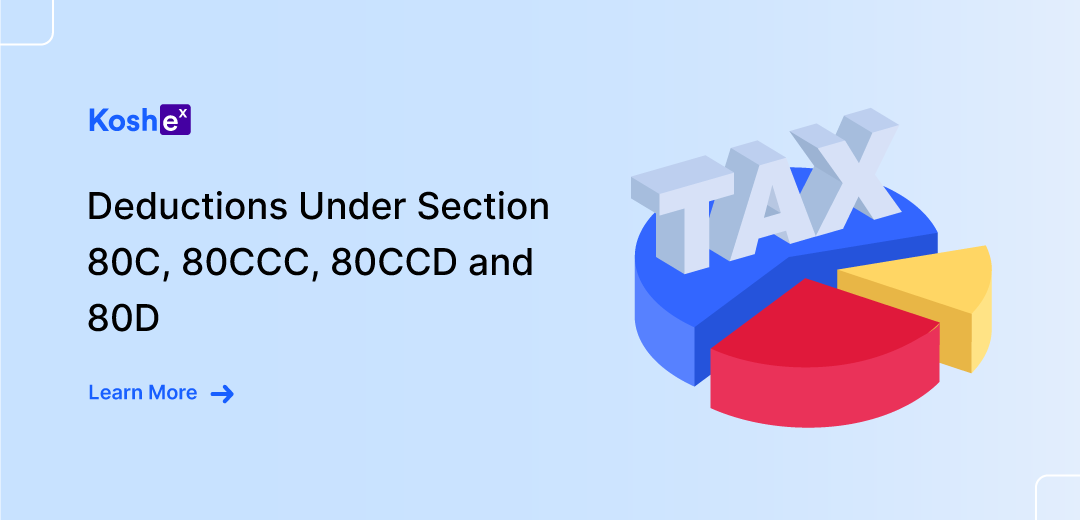Income Tax Deductions Under Section 80C, 80CCC, 80CCD, & 80D
An increase in income undoubtedly comes with higher growth prospects, but it also brings along more tax liability.
According to a 2022 article in Forbes, “Income Tax Deductions In India,” about eight crore people in India file personal taxes, with rates ranging from 5% to 42.74%. Every citizen with a certain income earned through a salaried job or other sources of income owes money in taxes.
Under Chapter VI A of the Income Tax Act, an assessee can claim tax deductions under Section 80C. This allows a tax-paying individual to be eligible for tax deductions by making investments to claim tax relief.
Individuals and Hindu Undivided Families (HUFs) can claim tax deductions under 80C. LLPs, Companies, or partnership firms cannot benefit from this deduction. Section 80C allows a maximum deduction of Rs 1.5 lakh yearly from a taxpayer’s total income.
The various subsections under 80C are 80CCC, 80CCD (1), 80CCD (1b), and 80CCD (2). Section 80CCD allows an additional deduction of Rs. 50,000.
Are You Eligible For Tax Deduction Under Section 80C?
Here’s a look at the eligible investments for tax deductions under 80C, 80CCC, 80CCD, and 80D.
Deductions under 80C
1. Employee Provident Fund (EPF)
All salaried individuals can claim a deduction up to a maximum of 1.5 lakhs through the employee’s contribution to EPF. The contribution is12% of one’s basic salary. However, the employer’s contribution is not eligible for deduction under 80C.
2. Public Provident Fund (PPF)
The Central government assures long-term investment through PPF. Investors can be eligible for tax deductions from Rs 500 to Rs 1.5 lakhs. After a minimum period of investment, which is 15 years, investors can withdraw the deposited funds. The PPF program allows premature closing after five years and partial withdrawals following six years of investment. The interest on PPF is tax-free.
3. Life Insurance Premiums
A life insurance policy not only provides financial security to the family of the policyholder but is also eligible for tax deduction under 80C.
The deduction can be claimed only for the assessee or their family members. The total amounts that can be claimed are 10% of the sum assured for policies issued after 1 April 2012 and 20% for policies issued before 31 March 2012. The overall deduction is up to Rs 1,50,000 for issues made before 31 March 2012.
4. Unit-linked insurance plan (ULIP)
A ULIP helps in saving money and generates considerable returns over an extended period. It features a lock-in period of five years and offers investors diverse fund investment possibilities. ULIPs combine investing and insurance.
A portion of the money invested in ULIPs goes toward providing insurance, and the remaining money is put toward stock market investments. Section 80C offers tax benefits for ULIP investments up to Rs 1.5 lakh.
5. Equity Linked Savings Scheme (ELSS)
It is an open-ended mutual fund scheme that invests primarily in stocks for high returns and offers tax advantages. You can invest a maximum of Rs. 1.5 lakh in ELSS per year to claim tax deductions under Section 80C.
ELSS comes with a fixed lock-in period of three years, and the deduction can be claimed only in the year when the investment is made.
6. Sukanya Samriddhi Scheme
Parents of a girl child less than 10 years old can benefit from this scheme. Investors can start from as little as Rs 1,000 and a maximum of Rs 1.5 lakh. The interest rate offered by the scheme is 8–8.5%.
7. National Savings Certificate (NSC)
NSC allows tax benefits of up to Rs.1.5 lakh with a fixed maturity period of 5 years. Investors need to put in a minimum of Rs.1000 at the rate of 6.8% per annum. This is a low-risk product like PPF and Post Office fixed deposits.
8. Children’s Tuition Fee
A tax deduction of up to Rs 1.5 lakh may be claimed under Section 80C for the tuition fees for approved schools, colleges, or universities for up to two children. The deduction can be claimed only for full-time courses.
9. Housing Loan
Tax deductions are available for principal payments made on loans taken to purchase or build residential properties. Additionally, stamp duty, registration fees, and transfer charges are eligible for this deduction.
10. Infrastructure Bonds
Infrastructure bonds get a tax credit of up to Rs 20,000 at the time of investment. However, the interest generated on these bonds is taxable. The taxable amount is the sum of the interest earned and the total income, and it is levied according to the investor’s tax slab.
11. Post Office Fixed Deposit
The TDS applicable on a post office FD is only if the interest amount is more than Rs. 40,000. The investors can earn an interest of 5.5% to 6.7% per annum under this scheme. They cannot cash a term deposit before six months. The interest rates are applicable for early withdrawals between six and twelve months.
Deductions Under 80CCC
The amount spent on a new insurance purchase or payments made toward the renewal or continuation of an existing policy is included in the Section 80CCC exemption limit.
The policy for which the money was paid must offer a pension or a periodic annuity to qualify for this exemption.
When read in conjunction with Sections 80C and 80CCD(1), Section 80CCC places a cap on the total exemption amount at Rs. 1,50,000 per year.
Only individuals are eligible for deductions per Section 80CCC. Here are a few things to keep in mind:
- The interest or bonuses from this plan are not qualified for tax deductions.
- The amount received upon plan surrender is subject to taxation.
- The amount of your pension is subject to taxation.
- Section 80CCC permits a deduction of up to Rs 1.5 lakh.
Section 80CCD
Section 80CCD encourages people to save by incentivizing them to invest in Central Government-approved pension plans. The contributions made by an individual and an employer qualify for a tax deduction provided that the deduction does not exceed 10% of the individual’s salary. Moreover, this deduction is only available to individual taxpayers.
It emphasises the person’s contributions National Pension Scheme (NPS) and Atal Pension Yojana.
Sections under 80CCD
- Section 80CCD (1): It relates to tax deductions for the self-employed, the government, and other employers. The highest allowable deduction for salaried workers is 10% of their salary. However, self-employed individuals may claim 10% of their gross income.
- Section 80CCD (2): This section mentions employer contributions to the NPS. Individuals who make pension contributions are entitled to a tax deduction per Section 80CCD. If an employer pays an employee’s NPS account, the employee may deduct the contribution from their taxes. Further, the limit is 10% of an employee’s salary.
- Section 80CCD (1B): The total tax savings for capital deposited in the NPS may reach Rs 2,00,000, with an extra tax advantage of Rs 50,000 available per Section 80CCD (1B).
Section 80D
Section 80D provides a tax deduction for health insurance premium payments. Under section 80D, taxpayers may claim up to Rs 25,000 for insurance coverage for themselves, their partner, and their dependant children.
If their parents are less than 60 years old, they may claim up to Rs 25,000 for their coverage. Those above the age of 60, though, may claim Rs 50,000 under this clause. If the taxpayer and parent(s) are at least 60 years old, the maximum deduction allowed under this section is Rs 1 lakh.
Conclusion
Section 80C is popular among the tax-paying population of India because it offers tax deductions on eligible expenses. Accurate information about this section would allow taxpayers to claim significant deductions.
Some investments under Sections 80C, 80D, and 80CCD include EPF, NPS, ELSS, PPF, and NSC. A HUF can benefit from deductions under Section 80C.
At Koshex, we help young investors do more with their money by offering ways to divert savings toward long and short-term goals, emergency funds, education, and home savings. Sign up with Koshex now for a financially rewarding life customized to your needs and risk appetite.
FAQ
- How are taxes deducted in India?
Tax deductions are claims made to lower your taxable income and result from a taxpayer’s varied investments and costs. Therefore, taking an income tax deduction reduces your entire tax obligation. It is a type of tax benefit that enables tax savings. However, the kind of tax benefit you claim will determine how much you can save. - What is the minimum taxable income in India?
The minimum annual taxable income is Rs. 2,50,000. The basic exemption limit is Rs. 3,00,000 for residents who are 60 but less than 80 years old. The limit is Rs. 5,00,000 for residents who are 80 years or older. There is no fundamental exemption limit for other entities, such as cooperative societies, businesses, and municipal authorities.









Leave a Comment